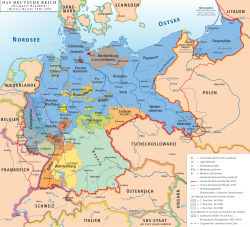Weimar Olómìnira
Gege bi Weimar Olómìnira (Weimar Republic) (![]() Weimarer Republik (ìrànwọ́·ìkéde), IPA: [ˈvaɪmaʁɐ ʁepuˈbliːk]) ni awon olukoitan n pe orile-ede olominira onileasofin ti o je didasile ni 1919 ni Jemani lati dipo iru ijoba tobaluaye to wa tele, won soloruko fun Weimar, ilu ti igbimo ilana-ibagbepo ti pade. Sibesibe, oruko tonibise re si duro si Deutsches Reich (Ile Obaluaye Jemani; German Empire). Leyin Ogun Agbaye Akoko, ile olominira yi loyojade lati Ijidide Jemani ni November 1918. Ni 1919, igbimo ile apapo pade ni ilu Weimar, nibiti won ti ko ilana-ibagbepo tuntun fun Raik Jemani (German Reich), won gba ni 11 August. Iru oseluaralu asolominira kose nile ni ibere awon odun 1930, eyi samona fun igori aga NSDAP ati Adolf Hitler ni 1933. Botilejepe ilana-ibagbepo odun 1919 ko je fifagile fun tonibise, awon ofin ti ijoba Nazi se ni February ati March 1933, to je mimo bi Gleichschaltung ("coordination") tumosi pe ijoba le sofin to tako ilana-ibagbepo. Ilana-ibagbepo ko niyi mo; bi be, odun 1933 ni won gba bi opin Weimar Olominira ati ibere "Raik Keta" ti Hitler.
Weimarer Republik (ìrànwọ́·ìkéde), IPA: [ˈvaɪmaʁɐ ʁepuˈbliːk]) ni awon olukoitan n pe orile-ede olominira onileasofin ti o je didasile ni 1919 ni Jemani lati dipo iru ijoba tobaluaye to wa tele, won soloruko fun Weimar, ilu ti igbimo ilana-ibagbepo ti pade. Sibesibe, oruko tonibise re si duro si Deutsches Reich (Ile Obaluaye Jemani; German Empire). Leyin Ogun Agbaye Akoko, ile olominira yi loyojade lati Ijidide Jemani ni November 1918. Ni 1919, igbimo ile apapo pade ni ilu Weimar, nibiti won ti ko ilana-ibagbepo tuntun fun Raik Jemani (German Reich), won gba ni 11 August. Iru oseluaralu asolominira kose nile ni ibere awon odun 1930, eyi samona fun igori aga NSDAP ati Adolf Hitler ni 1933. Botilejepe ilana-ibagbepo odun 1919 ko je fifagile fun tonibise, awon ofin ti ijoba Nazi se ni February ati March 1933, to je mimo bi Gleichschaltung ("coordination") tumosi pe ijoba le sofin to tako ilana-ibagbepo. Ilana-ibagbepo ko niyi mo; bi be, odun 1933 ni won gba bi opin Weimar Olominira ati ibere "Raik Keta" ti Hitler.
| |||||||||||||||||||||||||||||||||||||||||||||||||||||||||||||||||||
Ni odun 14 ti Weimar Olominira fi wao koju opolopo awon isoro, ninu won ni Owonpupo, awon oloselu alaseju ati awon ologun oto won, ati ikorira latowo awon asegun Ogun Agbaye Akoko. Sibesibe, o bori awon ilana buburu Iwe-ipinnu Versailles, o se atunse owonina, seisodokan iselu owo-ode ati sistemu onaojurin.


